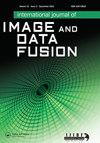Enabling real-time and high accuracy tracking with COTS RFID devices
IF 1.8
Q3 REMOTE SENSING
International Journal of Image and Data Fusion
Pub Date : 2020-04-21
DOI:10.1080/19479832.2020.1752315
引用次数: 3
Abstract
ABSTRACT RFID technology has been widely used for object tracking in the industry. Very high accuracy (centimetre level) positioning based on RFID carrier phase measurement has been reported. However, most of the proposed fine-grained tracking methods can only work with very strict preconditions. For example, some methods require either the reader or the tag to move along a certain one dimensional track at constant speed, while other methods need pre-deployed tags at known locations as reference points. This paper proposes a new approach which can track RFID tags without knowing the speed, the track and the initial location of the tag, and requiring only the antenna coordinates. The experiment results show that the algorithm can converge within 10 seconds and the average positioning accuracy can be at the centimetre level or even sub-centimetre level under different preconditions. The algorithm has also been optimised with a prediction-updating procedure to meet the requirements of post-processing and real-time tracking.使用COTS RFID设备实现实时高精度跟踪
摘要RFID技术已在工业中广泛应用于物体跟踪。已经报道了基于RFID载波相位测量的非常高精度(厘米级)定位。然而,大多数提出的细粒度跟踪方法只能在非常严格的前提条件下工作。例如,一些方法需要读取器或标签以恒定速度沿着某个一维轨道移动,而其他方法需要在已知位置预先部署标签作为参考点。本文提出了一种新的方法,可以在不知道标签的速度、轨迹和初始位置的情况下跟踪RFID标签,并且只需要天线坐标。实验结果表明,该算法可以在10秒内收敛,在不同的前提条件下,平均定位精度可以达到厘米级甚至亚厘米级。该算法还通过预测更新程序进行了优化,以满足后处理和实时跟踪的要求。
本文章由计算机程序翻译,如有差异,请以英文原文为准。
求助全文
约1分钟内获得全文
求助全文
来源期刊

International Journal of Image and Data Fusion
REMOTE SENSING-
CiteScore
5.00
自引率
0.00%
发文量
10
期刊介绍:
International Journal of Image and Data Fusion provides a single source of information for all aspects of image and data fusion methodologies, developments, techniques and applications. Image and data fusion techniques are important for combining the many sources of satellite, airborne and ground based imaging systems, and integrating these with other related data sets for enhanced information extraction and decision making. Image and data fusion aims at the integration of multi-sensor, multi-temporal, multi-resolution and multi-platform image data, together with geospatial data, GIS, in-situ, and other statistical data sets for improved information extraction, as well as to increase the reliability of the information. This leads to more accurate information that provides for robust operational performance, i.e. increased confidence, reduced ambiguity and improved classification enabling evidence based management. The journal welcomes original research papers, review papers, shorter letters, technical articles, book reviews and conference reports in all areas of image and data fusion including, but not limited to, the following aspects and topics: • Automatic registration/geometric aspects of fusing images with different spatial, spectral, temporal resolutions; phase information; or acquired in different modes • Pixel, feature and decision level fusion algorithms and methodologies • Data Assimilation: fusing data with models • Multi-source classification and information extraction • Integration of satellite, airborne and terrestrial sensor systems • Fusing temporal data sets for change detection studies (e.g. for Land Cover/Land Use Change studies) • Image and data mining from multi-platform, multi-source, multi-scale, multi-temporal data sets (e.g. geometric information, topological information, statistical information, etc.).
 求助内容:
求助内容: 应助结果提醒方式:
应助结果提醒方式:


